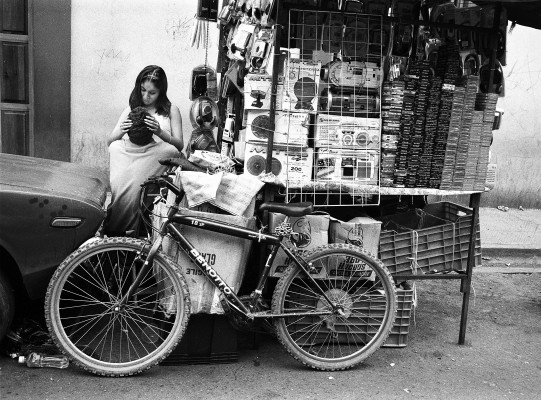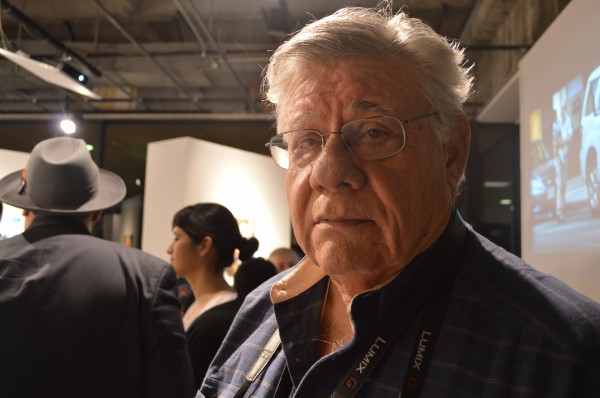With one quick motion of his finger on the camera shutter release, David Smith-Soto erases the boundaries of time and eternalizes an intimate instant as two lovers stare into each other’s eyes.
“It’s a glimpse of intimacy,” said David Flores, photographer and special collections archivist at the University of Texas at El Paso. “This is life one frame at a time.”

The black and white photograph taken in Oaxaca, Mexico, in 2000 entitled “Lovers” is one of 26 prints in David Smith-Soto’s street photography exhibit in the Glass Gallery at the University of Texas at El Paso,
Photo Gallery: The Street Photography of David Smith-Soto
Smith-Soto said he was pleased to show some of his 60 years of photography to a large audience, but that the purpose of the show was to raise funds for journalism student internships.
“We need to send out more students into the world, so that means we need more funding for that,” said Zita Arocha director of Borderzine, UTEP’s online bilingual magazine. Arocha said it costs approximately $3000 to send one student on an internship.

Elida Perez observes Soto’s street photography. Photo credit: Maria Esquinca
Elida Perez, one of Smit-Soto’s first students was sent on three internships while she was a student at UTEP. Perez said the experience she gained from the internships was invaluable.
Currently a staff writer covering education at the El Paso Times, Perez said, “I can’t imagine a newsroom hiring me were it not for my internship experience.”

David Smith Soto. Photo credit: Maria Esquinca
Smith-Soto said he will personally handcraft a print and give it free of charge to anyone who makes a monetary contribution to Borderzine.com. Smith-Soto said he enjoys the process of digital printing because it can save or improve an image.
“This picture would’ve been virtually impossible without digital processing,” Soto said while pointing at a hazy grainy photo of a little girl taken in 1954 with a box camera. The girl looks about three years old and sits innocently at the front doorstep of her house. Smith-Soto was was nine years old when he took the picture of his neighbor with a Kodak Brownie camera his father had given him as a gift.
He was very nearsighted as a child and when he saw the picture for the first time he saw details that he had not noticed before. “I was nearsighted when I was a little boy, virtually blind,” Smith-Soto said. “I learned to see with a camera.”

Photo’s from Soto’s street photography gallery. Photo credit: Maria Esquinca
Smith-Soto has never let go of a camera since then. In an article titled “Seeing Life on the Streets Through my Leica,” Soto wrote, “A Leica camera was always with me, almost as part of my body — my eyes. Although I earned my living as a writer, editor and manager, photography has been my enduring passion.”
Smith-Soto said that through the years photography became more than a hobby. It was an art form that allowed him to make a statement about the human condition. “This goes beyond journalism,” Smith-Soto said.
Thomas Ruggiero, journalist and associate professor of communication at UTEP, compared Smith-Soto’s photography to that of the photographer Henri Cartier Bresson.
“It sort of captures life right there in the instant,” Ruggiero said. “His work is art. It rivals any painting I’ve ever seen.”
Indeed, it seems to be Smith-Soto’s ability to captures life’s sporadic moments that fans of his photography appreciate the most.
Richard Pineda, associate professor of communication at UTEP, recalled the moment he had first seen one of Smith-Soto’s pictures of an ordinary man sitting on a bar stool. He was struck by the photo. “In that moment you saw that person’s humanity,” Pineda said. “You were right there next to him.”
Smith-Soto said that when he’s doing street photography he’ll take a dozen pictures of the same scene and sometimes something interesting happens.
“Street photography is something that is there one second and is gone the next,” said photographer Francisco Villa. “It’s not perfection, it’s something spontaneous that happens.”

DAVID, You know I admire your photography (fotografy). I will, gladly, happily, send a donation to Borderzine to have one of your personalized fotos. So many fotos, so little time!